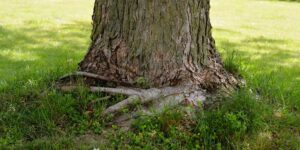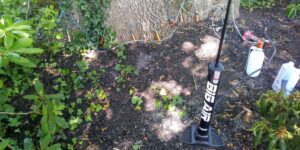You’ve just planted a new tree on your property. Now what? Many people assume that planting a tree is the hardest part of the job; once it’s in the ground, it will be fine with just a bit of water. But the reality is that your newly-planted tree will need some extra care as it adjusts to its new environment and begins to grow strong and healthy.
But don’t worry – this guide is here to help you ensure that your new tree grows to become firmly rooted, stable, and healthy. And it all starts with a few things that should happen before the tree is even planted.
Follow these steps and pretty soon you’ll be experiencing all of the many benefits that trees provide, making your effort more than worthwhile.
1. Be sure that the tree is planted properly
Right Tree, Right Place
Without the right growing conditions, a new tree won’t have a chance. Be sure that you plant the tree in the right location by asking yourself these questions:
- Will it have enough room to grow – for both height and width?
- Will the roots end up under a sidewalk, patio, or roadway where they can cause damage?
- Does the location provide the right amount of light? For example, if it needs full sun be sure it gets at least 6 hours of direct sunlight.
- Is it appropriate for our area? Link to zones map. If you choose a tree species that doesn’t like the cold, for instance, it probably won’t last long.
Many of the tree problems that we, as arborists, encounter stem from the wrong tree being planted in the wrong place.
A Tree With Flare
After you ensure that the location really does work for your type of tree, make sure that it’s planted at the right depth.
Does it look like a telephone pole sticking out of the ground, or can you see the area at the base of the trunk where it starts to get wider, just above the top of the roots? We call this the trunk flare, and it’s important that the trunk flare is above ground level. If it’s buried, the tree will have a lot of problems. (Note that in many cases, a tree bought in a container or balled and burlapped will have the trunk flare buried, so you will have to uncover it before planting.).
If you’re not sure about how to plant your tree, or whether a tree has been properly planted, give us a call. We offer inspections, as well as tree planting services to make it as easy as possible to add new trees to your property.
2. Water, water, water (but not too much!)
How to Water Your Newly-Planted Tree
Immediately after your tree has been planted, be sure to water it deeply every day. Watering deeply means making sure that the water reaches down to the roots; the way to achieve this is by watering slowly for a longer period of time.
Sprinklers are great for watering gardens and lawns, but not for trees. While they spray water on the trunk and the leaves, they don’t allow enough water to reach the roots. And unlike lawns, trees need water less frequently but in greater quantities. A sprinkler system that’s set up to keep your lawn lush and green simply won’t meet the needs of a newly-planted tree.
We recommend a drip irrigation system, a soaker hose, or even a garden hose – anything that can emit water slowly and for a long time.
Don’t water near the trunk. Instead, concentrate water in the area of the root ball and then the area around it. This will encourage the roots to reach outwards.
How Often to Water
As for your watering routine, here are some general guidelines:
- For a trunk diameter of less than 2″, water daily for 2 weeks, then weekly
- For a trunk diameter of 2″ to 4″, water daily for 1 month, then weekly
- For anything larger than 4″, water daily for 6 weeks, then weekly
Continue watering at this rate until the tree is established (usually well into the fall).
How Much Water to Use
Check the ground around your tree (under the layer of mulch) between waterings. You want it to be moist, but not soaking wet.
Dig out a bit of the soil and feel it in your hands. If it blows away, it’s too dry and should be watered. If you can squeeze out water, it’s too wet and doesn’t need to be watered at that time. You want soil that holds its shape, but isn’t too mushy and doesn’t turn dusty and blow away.
A tree needs 10 gallons of water per week for each inch of diameter of the tree. So, for instance, a 2-inch wide sapling will need 20 gallons of water each week.
Long and deep waterings are better than short and frequent. If you’re using a soaker hose or a slow drip system, this means at least 2 hours of watering each time.
Keep an eye on the weather. If it’s especially hot, you may need to water your new tree more often and/or provide more water. If it’s a rainy week, shut off any irrigation systems – you don’t want to over water a tree (trees can suffocate and drown if they’re sitting in too much water!).
3. Mulch to retain moisture and regulate temperatures
You may be used to seeing trees surrounded by grass or flowers, and so you might be tempted to follow suit. Remember, though, that grass is also a plant, and it will be competing for the water, nutrients, and other resources in the area.
The best option is to remove the grass around a tree (it will make lawn mowing much easier anyway) and to put down a layer of organic mulch.
Good choices for mulch include:
- Leaf litter/leaf mulch
- Pine straw
- Wood chips (you can get free wood chips from Alpine Tree – just give us a call!)
- Shredded bark
Mulch is great at retaining moisture, adding organic nutrients to the soil, and regulating the soil temperature. It also stops weeds from sprouting and ensures that you won’t accidentally injure your newly-planted tree with a string trimmer or mower.
How to Use Mulch
To take advantage of the many benefits of mulch, be sure that you place your mulch 3 to 4 inches away from the tree trunk. Any mulch touching your tree can severely harm it by encouraging rot and making it easier for pests to attack.
Despite what you may have seen at local parks, your mulch should never look like a volcano piled up around the tree trunk. Keep the mulch spread out in one flat, level surface. And be sure you can still see the root flare that we mentioned earlier!
Spread the mulch about 2 to 4 inches deep maximum; this is NOT a case of “more is better”. Up to 6 inches can be used around trees as long as it’s not piled into a volcano)
The further out from the tree that the mulch extends, the better, as it will help to protect roots as they grow. Try to place it at least as far out as the tree’s leaves, or canopy. As the tree grows, its roots will continue to grow outward. Sometimes, a tree’s roots can extend out two to three times farther than the canopy!
4. What’s at stake with staking
Most often, a newly-planted tree won’t need to be staked. But, if for some reason it does, be sure to remove the stakes after a year (two at the most).
Stakes that are left in place too long will prevent the tree from establishing a secure root system, developing the proper form, and being able to withstand winds. Plus, leaving the stakes (and/or any straps attached to the tree) in place can eventually kill your tree.
>> Get the details on when you should and should not stake a tree
5. To fertilize or not to fertilize
We recommend not fertilizing your tree for the first few years, as the roots need time to stretch out and establish themselves first. The fertilizer generally won’t help the roots those first few years.
Instead, consider organic mulch, which acts as a slow-release fertilizer. Another option is to add mycorrhizal fungi to the soil when you plant your tree, but opinions are mixed as to whether that helps or not.
A soil test and a consultation with an arborist can help you determine the best course of action for your trees when it comes to fertilization and soil amendments.
For more details about fertilizing trees, see our FAQs about tree fertilization, including when and how to fertilize, New Jersey’s fertilizer law, organic alternatives, and more.
6. Procrastinate on Pruning
Let the tree grow for at least one full season before considering any corrective pruning. The tree will need all the energy it can get (from photosynthesis in the leaves) to help it develop a strong root structure.
If any branches have been damaged during the transportation and/or planting process, those can be removed right away.
7. Spend time with your tree
The most important thing is to keep an eye on your new tree. As with anything that’s been newly planted, watch for insect or disease problems. These are more common when the plant is stressed, such as when it’s just been transplanted. And make sure the soil isn’t settling or the roots popping up.
After the first few years, the tree will settle into its new environment and will need less care, but it’s always good to check on it every so often. Plus, spending time with trees is good for you!
And if you notice something that seems off, call us at 973-964-7798 to set up a professional consultation. It’s always best to address any issues right away to give your new tree the best chance of living a long, healthy life.




